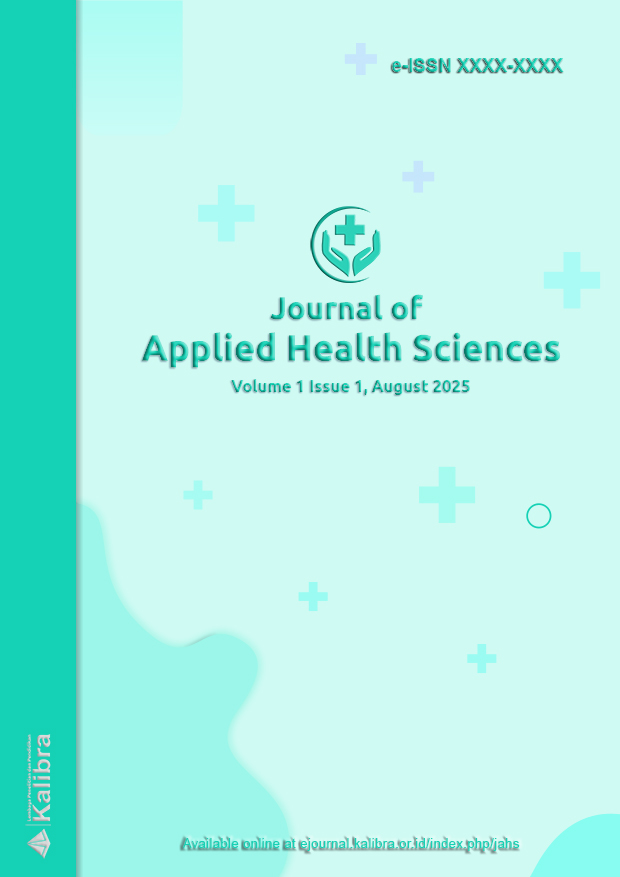Efektivitas Edukasi Gizi terhadap Penurunan Berat Badan pada Remaja Obesitas
Keywords:
adolescent obesity, nutrition education, weight loss, health intervention, balanced nutritionAbstract
Adolescent obesity is a growing public health problem that contributes to the risk of degenerative diseases in adulthood. One of the effective interventions to address obesity is nutrition education, which aims to improve adolescents’ knowledge and skills in selecting and consuming healthy foods. This study aimed to analyze the effectiveness of nutrition education in reducing body weight among obese adolescents. A quasi-experimental design with a pre-test and post-test approach was employed in the intervention group. The sample consisted of 40 obese adolescents selected using purposive sampling. The nutrition education intervention was conducted for 8 weeks through interactive lectures, group discussions, and individual counseling sessions, covering topics such as balanced nutritional needs, portion control, healthy food selection, and the importance of physical activity. Body weight was measured before and after the intervention and analyzed using a paired t-test. The results showed a significant decrease in body weight in the intervention group (p < 0.05), with an average reduction of 2.3 ± 0.8 kg. These findings indicate that structured and continuous nutrition education can be an effective strategy for reducing body weight in obese adolescents. This study recommends integrating nutrition education programs into school and community activities as part of efforts to prevent and control adolescent obesity.
References
Alves, M. A., Martins, M. C., & Almeida, L. M. (2019). Effectiveness of nutrition education programs for adolescents: A systematic review. Journal of Nutrition Education and Behavior, 51(5), 539–552.
Birch, L. L., & Ventura, A. K. (2009). Preventing childhood obesity: What works? International Journal of Obesity, 33(S1), S74–S81.
Boyland, E. J., & Whalen, R. (2015). Food advertising to children and its effects on diet: Review of recent prevalence and impact data. Pediatric Diabetes, 16(5), 331–337.
Contento, I. R. (2016). Nutrition education: Linking research, theory, and practice (3rd ed.). Jones & Bartlett Learning.
Creswell, J. W. (2014). Research design: Qualitative, quantitative, and mixed methods approaches (4th ed.). SAGE Publications.
Driessen, C. E., Cameron, A. J., Thornton, L. E., Lai, S. K., & Barnett, L. M. (2014). Effect of changes to the school food environment on eating behaviours and/or body weight in children: A systematic review. Obesity Reviews, 15(12),
Ho, M., Garnett, S. P., Baur, L., Burrows, T., Stewart, L., Neve, M., & Collins, C. (2013). Effectiveness of lifestyle interventions in child obesity: Systematic review with meta-analysis. Pediatrics, 132(6), 161–171.
Kelishadi, R., Ardalan, G., Gheiratmand, R., Gouya, M. M., Razaghi, E. M., Delavari, A., Majdzadeh, R., Heshmat, R., & Motaghian, M. (2014). Thinness, overweight and obesity in a national sample of Iranian children and adolescents: CASPIAN Study. Child: Care, Health and Development, 34(1), 44–54.
Langford, R., Bonell, C., Jones, H., Pouliou, T., Murphy, S., Waters, E., Komro, K., Gibbs, L., Magnus, D., & Campbell, R. (2015). The WHO Health Promoting School framework for improving the health and well‐being of students and their academic achievement. Cochrane Database of Systematic Reviews, 4.
Michie, S., van Stralen, M. M., & West, R. (2011). The behaviour change wheel: A new method for characterising and designing behaviour change interventions. Implementation Science, 6(1), 42.
Nguyen, B., Shrewsbury, V. A., O’Connor, J., Flood, V. M., & Baur, L. A. (2016). Two-year outcomes of an adolescent obesity intervention: The Loozit randomized controlled trial. International Journal of Obesity, 37(4), 468–477.
Prochaska, J. O., & Velicer, W. F. (1997). The transtheoretical model of health behavior change. American Journal of Health Promotion, 12(1), 38–48.
Sadeghirad, B., Duhaney, T., Motaghipisheh, S., Campbell, N. R., & Johnston, B. C. (2016). Influence of unhealthy food and beverage marketing on children’s dietary intake and preference: A systematic review and meta-analysis of randomized trials. Obesity Reviews, 17(10), 945–959.
Spruijt-Metz, D., Nguyen-Michel, S. T., Goran, M. I., Chou, C.-P., & Huang, T. T.-K. (2014). Reducing sedentary behavior in minority girls via a theory-based, tailored classroom media intervention. International Journal of Pediatric Obesity, 4(4), 247–255.
Story, M., Neumark-Sztainer, D., & French, S. (2002). Individual and environmental influences on adolescent eating behaviors. Journal of the American Dietetic Association, 102(3), S40–S51.
Wang, L. Y., Denniston, M., Lee, S., Galuska, D., & Lowry, R. (2015). Long-term health and economic impact of preventing and reducing overweight and obesity in adolescence. Journal of Adolescent Health, 46(5), 467–473.
Weng, S. F., Redsell, S. A., Swift, J. A., Yang, M., & Glazebrook, C. P. (2013). Systematic review and meta-analyses of risk factors for childhood overweight identifiable during infancy. Archives of Disease in Childhood, 97(12), 1019–1026.
World Health Organization. (2020). Obesity and overweight: Fact sheet. WHO. https://www.who.int/news-room/fact-sheets/detail/obesity-and-overweight
Yip, C., Gates, M., Gates, A., & Hanning, R. M. (2016). Peer-led nutrition education programs for school-aged youth: A systematic review of the literature. Health Education Research, 31(1), 82–97.
Downloads
Published
How to Cite
Issue
Section
License
Copyright (c) 2025 Kiki Arianti, Rizki Amalia Putri

This work is licensed under a Creative Commons Attribution-ShareAlike 4.0 International License.








